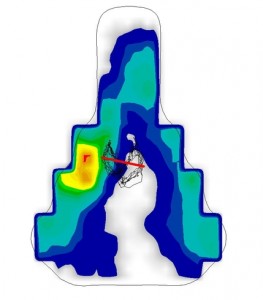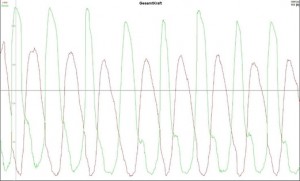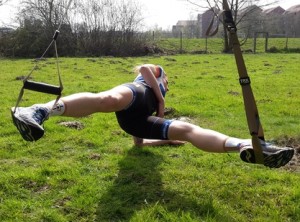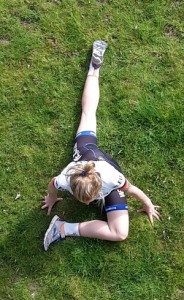Stability is key
Experts agree that a stable, well-controlled core is decisive for an effective force transmission and relevant for riding comfortably. However, it is not easy to get to know the individual reasons for an unbalanced core – training laziness is a favorite but often incorrect or at least insufficient explanation. All of us know that even the strongmen among our sport buddies occasionally suffer from discomforts on the bike. In my blog entry on pelvic obliquity I have covered a classic background for lasting back pain and sitting problems: a rotation of the hip that is often caused by uneven muscle force.
This relatively minor malposition can cause pain during endurance efforts – such as cycling. Furthermore, it can decrease the performance by limiting the muscular stability at the most important point on contact: the saddle.
In a professional bike fitting it is now relevant to assess whether the athlete can benefit from a specific training to successfully counteract the rotation or whether the rider should be referred to a coach or physiotherapist. The latter would be necessary if the ideal sitting position and a targeted training program are likely to be insufficient to solve the problem. In this regard ‘professional’ also includes knowing the limits of the own profession and not generating false hopes.
I would like to take the case of a rider from our lab to illustrate this point. This hopefully gives the fitters among you an idea about the critical decision-making and the riders among you an idea whether your problems could be caused by pelvic obliquity.
Our example is a rider with sufficient kilometers under her belt to ride without major discomforts and who is also no stranger to strength training. Basically she’s fit as a fiddle but has some pinches here and there. Even though the problems only relate to cycling, she still suffers from back pain following long or short and intense sessions. She also has already tried different saddle types but is not entirely happy with the current model either – let’s leave it at that for privacy’s sake. On the long hard climbs in the training camp she furthermore experienced intense, piercing pain in the outer knee. A sports doctor diagnosed this as ‘runners knee’, i.e. the overstraining of the tendons along the hamstring (tractus femoris/ IT-band).
Before she starts on the bike in the lab, when measuring the sacrum angle during the body examination we saw that the right ilium was slightly higher than the left. This is a first indication that often becomes more visible on the bike but needs a bit of experience to be identified.
In the frog position, where the soles of the feet are put together while lying on the back and the hips are rotated outwards, she feels that this works considerably easier on the left side. This is also a good self-test to keep an eye on your hip balance.
In the motion analysis on the bike, we can clearly see an increased inwards rotation of the thigh towards the shin with a stable foot joint – which is typical for a tilted ilium position. Also the saddle pressure measurement shows the specific pressure distribution of a hip rotation: maximum pressure spots in the area of the left pubis explain the saddle discomfort and the center of pressure shows the suboptimal stability.
The measurement confirms that the force is unevenly transmitted to the pedals. Differentiating between cause and effect is only possible when having the rider in the lab for several measurements. In this example, I knew from previous tests that the rider usually has a good left/right-balance so that I can use the force curve as analysis- and control variable – an improvement of the force balance during the fitting confirms that we are on the right track.
To assess whether we as bikefitters should aim at limiting the rotatory malposition by including some training measures, a ‘try-out’ session is in order:
We work for 15 minutes with effective exercises that the athlete can do at home. These exercises serve to counterbalance those muscles that we assume cause the hip rotation. The program consists of two intense exercises using a suspension trainer and sequencing is important: the first 15 reps are performed with the right side, the second with the left, i.e. the side of the hip that is supposed to rotate backwards.
After a short warm-up, we will start with the suspension trainer:
1: In the suspension trainer the legs are maximally split while holding a side plank.
2: A one-legged lunge is performed in the suspension trainer.
3: At the end, the hip flexor will be stretched statically for 5 minutes.
What does this tell me? Obviously, I cannot expect a training effect after such a short time. A repeated analysis of the pressure mapping on the saddle helps to decide: If we see a significant improvement, we can assume that she will benefit from a goal-oriented program to manage her discomforts.
If, however, there are no changes, we advise her to visit a physiotherapist or doctor with a manual therapeutic education to remove a joint-blockage. Even in this case, the program is a valuable addition to support the long-term success of the manual therapeutic measures. A hip malpositioning is nothing that ‘just happens’. Rather, it is the result of repeatedly putting unbalanced everyday or sport-specific demands on the body. Accordingly, you have to work just as hard to get back into balance as you have worked to get out of balance in the first place.
In this regard, a follow-up after 2-4 weeks is important. If the measures were successful, a phone call might suffice: “Everything fine? Everything fine!”. If not, the causes should be further analyzed, as overstraining injuries should be taken seriously. Otherwise the body will force the athlete into a prolonged break at some point that likely reduces the performance more than exchanging some time on the bike for time spent with the physiotherapist or bikefitter.
ISCO Level 2 bikefitter can order the exact diagnosis and treatment plan from me. Of course, I would also appreciate your feedback!
The pictures of the exercises were reconstructed to illustrate the described methods.
Author: Lotte Kraus








